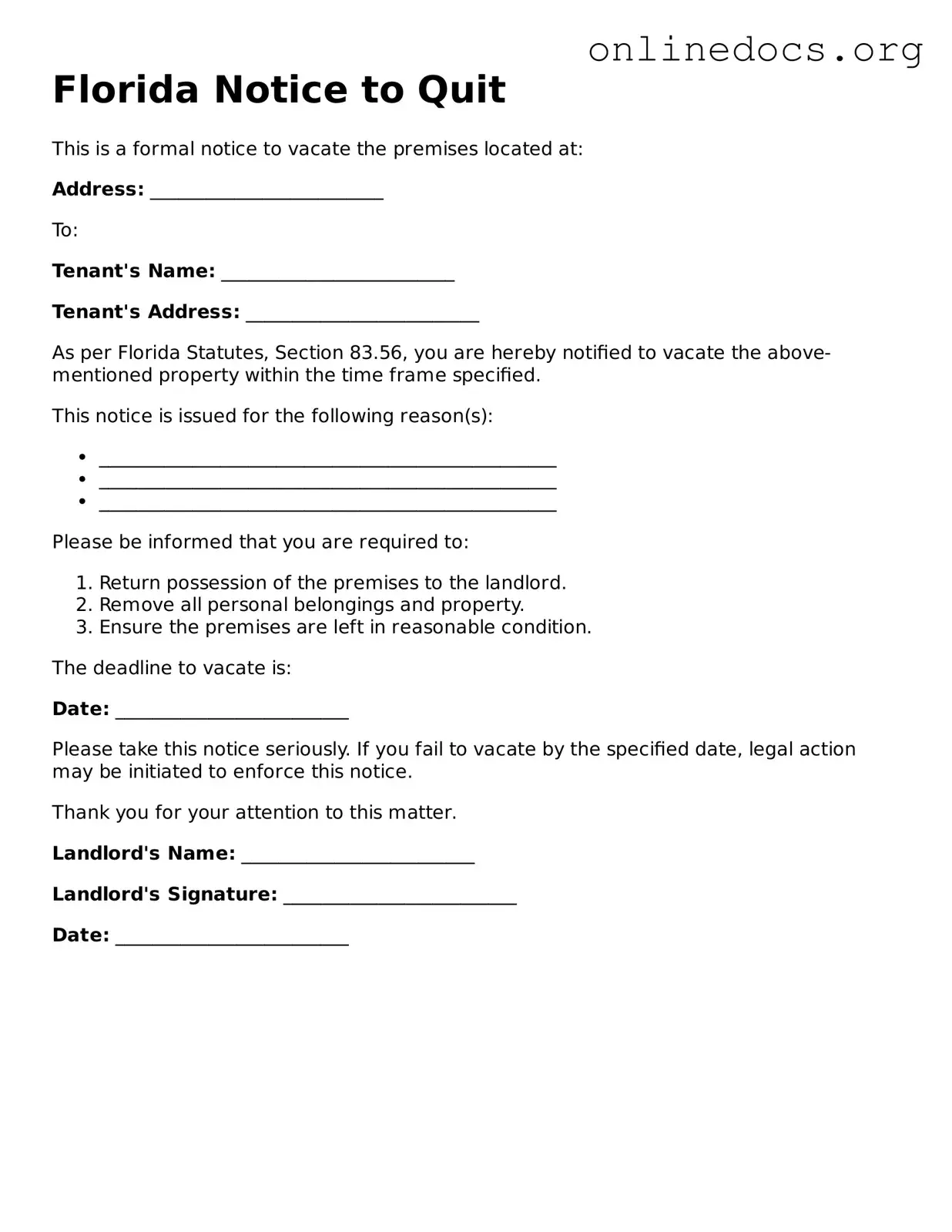The Florida Notice to Quit form is similar to the Eviction Notice, which landlords use to inform tenants of their intention to terminate a lease agreement. This document outlines the reason for eviction, such as non-payment of rent or lease violations, and specifies a deadline by which the tenant must vacate the premises. Both forms serve to initiate the eviction process and provide a clear communication channel between landlords and tenants regarding the need to vacate the property.
To secure your assets and provide for your loved ones, it is crucial to draft your own comprehensive Last Will and Testament. This document enables you to articulate your wishes clearly, ensuring that your assets are allocated according to your preferences. For more information on how to create this vital legal document, visit our resource on blank Last Will and Testament forms.
Another related document is the Notice of Lease Termination. This notice is typically issued by landlords to inform tenants that their lease will not be renewed at the end of the term. Like the Notice to Quit, it specifies a timeframe for the tenant to vacate the property. The key difference lies in its use; the Notice of Lease Termination is often used when a lease is expiring, while the Notice to Quit may be used at any time during the lease for specific violations.
The Demand for Possession is also comparable to the Notice to Quit. This document is used by landlords to formally request that a tenant vacate the property, usually after a failure to pay rent. The Demand for Possession typically includes a specific timeframe for the tenant to respond or vacate, similar to the Notice to Quit. Both documents aim to prompt action from the tenant to avoid further legal proceedings.
The Rent Demand Notice shares similarities with the Notice to Quit, particularly in cases of non-payment. This document serves as a formal request for overdue rent, specifying the amount owed and providing a deadline for payment. If the tenant fails to comply, the landlord may then proceed with a Notice to Quit. Thus, both documents are crucial steps in the eviction process related to financial obligations.
The Notice of Default is another document that resembles the Notice to Quit. This notice is often used in the context of mortgage agreements, notifying a borrower that they are in default on their loan. While it primarily pertains to property ownership rather than tenancy, both notices serve as formal warnings that legal action may follow if the recipient does not take corrective measures within a specified timeframe.
The Cure or Quit Notice is similar in purpose to the Florida Notice to Quit. This document is issued to inform tenants of a lease violation, such as unauthorized pets or excessive noise, and gives them an opportunity to correct the issue. If the tenant fails to remedy the violation within the stated period, the landlord may proceed with eviction. Both notices emphasize the importance of communication and provide tenants with a chance to rectify their situations.
The Notice of Non-Renewal is akin to the Notice to Quit in that it informs tenants that their lease will not be extended. This document is typically issued well in advance of the lease's expiration date, allowing tenants time to make arrangements for moving. While the Notice to Quit may be issued for various reasons during the lease term, the Notice of Non-Renewal focuses specifically on the end of the lease period.
The Written Warning serves a similar function to the Notice to Quit by addressing tenant behavior that violates lease terms. This document is less formal and may be used to address minor infractions before escalating to eviction proceedings. Both documents highlight the importance of clear communication and provide tenants with an opportunity to correct their behavior before facing more serious consequences.
Lastly, the Notice of Intent to Vacate is comparable to the Notice to Quit in that it is a formal notification from tenants to landlords that they plan to leave the property. This document typically includes the intended move-out date and may help facilitate a smoother transition for both parties. While the Notice to Quit is initiated by the landlord, the Notice of Intent to Vacate reflects the tenant's decision to end the rental agreement.
